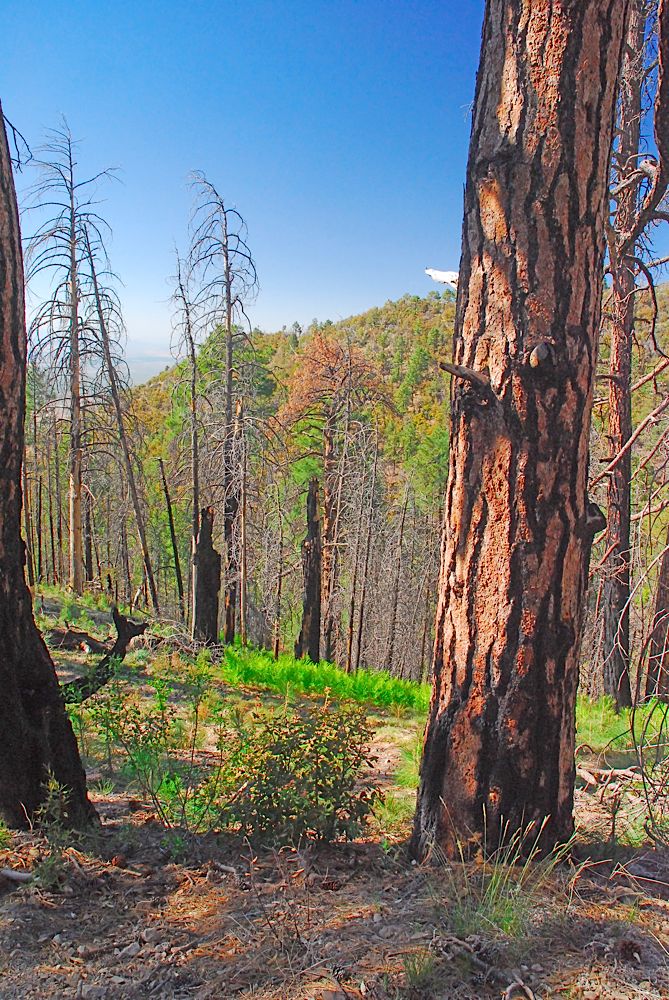Fire on the Mountain
 In June I trekked with a friend to the top of the Sierra El Pinito, a good-sized Sky Island just Southeast of Nogales. The Sierra El Pinito nudge their way into the pine forest community at 2230 meters, high enough to compete for serious Sky Island status in Sonora. They are just South of the border from the Santa Ritas and Patagonias on the US side, but because of the the political boundary they are a world away when it comes to fire suppression and natural fire regimes.
In June I trekked with a friend to the top of the Sierra El Pinito, a good-sized Sky Island just Southeast of Nogales. The Sierra El Pinito nudge their way into the pine forest community at 2230 meters, high enough to compete for serious Sky Island status in Sonora. They are just South of the border from the Santa Ritas and Patagonias on the US side, but because of the the political boundary they are a world away when it comes to fire suppression and natural fire regimes.
To drive the point home the Sierra Azul, just to the south, was actively burning. The fire had burned a significant percentage of the range by the time we laid eyes on it. By the time we left the area it had burned itself out naturally. Little is done to combat wildfires and indeed, in contrast to U.S. fire policy, people don't treat every wildfire as an utterly dire situation.
In my 15 years of experiences in Sonora I’ve seen people with a very different attitude toward fire than I am used to. Little is done to suppress wildfires in Mexico. Fires often burn mountains, grasslands, and even buffelgrass sided freeways, just to burn themselves out without much attention from authorities or locals. Combined with the lack of resources to fight wildfire in Mexico, this has created vegetation communities with a substantially different fire regime than similar communities on the U.S. side of the border.
Some conditions that affect the spread of natural wildfire are unfortunately still present in Sonora, such as cattle grazing and logging. Luckily a few rugged and/or remote locations have even been spared these effects.
 This dramatic difference in fire management bisecting the Sky Islands offers an opportunity to study the differences as well as the massive problems associated with fire suppression in Arizona and the West in general.
This dramatic difference in fire management bisecting the Sky Islands offers an opportunity to study the differences as well as the massive problems associated with fire suppression in Arizona and the West in general.
I've always been interested in wildfire and how it interacts with vegetation communities. In the last few years I've had my eyes opened to the vast differences in the on-the-ground reality of forest fire and the rhetoric of fire suppression advocates, and in the media. In the U.S. there is an amazing acceptance of anti-fire rhetoric by most everyone including scientists, land managers, and others who should know better. Thankfully the smoke has started to clear with recent advances in management by land management agencies in certain areas and agencies.
Of course the astronomical cost of fighting forest fires have also caused agencies to reconsider such heavy handed firefighting efforts.
The Rodeo-Chedeski fire on Arizona’s Mogollon Rim, in most people's minds, was a horrible fire that destroyed vast areas of Arizona's Mogollon Rim country. The Center for Biological Diversity was fighting a proposed "salvage" logging operation after the fire, which gave me an opportunity to spend several days documenting the aftermath of the fire.
What I found surprised even me. For the most part he fire did exactly what it was supposed to do under natural conditions in Ponderosa Pine country. It killed thickets of young pine, burned duff, extra fuel, and the lower branches of many of the older pines, protecting them from future fire.
Only a few areas were utterly torched. Inevitably these areas had been clear-cut a few decades earlier and had grown back in thick, monotonous stands of young trees, perfect for spreading a hot crown fire.
As seen in this photo, pines that were logged in this “salvage” operation were huge old growth pines that are capable of withstanding fires of this caliber, and in fact had withstood dozens of fires in able to be there at all.
In the Sierra Pinito, where fire is a very regular occurrence, I saw hundreds of pines (Apache, Arizona, and Chihuahua) and every individual had a fire scar. I am not exaggerating. And considering that, I can’t even say for certain that I saw a single pine killed by fire.
Most of the Pinito is dominated by oak and pine-oak forest. Some areas of oak had been fire-killed and replaced by thickets of younger oak. These were generally in small patches on ridges and a few steep slopes. These mosaics of fire-kill are indeed very beneficial to the ecosystem. They create a wide variety of habitat types for more diverse assemblages of flora and fauna.
Unfortunately most old-growth pine in the Sierra Pinito had been cut by loggers on the 40’s and 50’s, but enough time has passed that the pines, though certainly not old growth, are now big enough to constitute a real, healthy, functioning pine forest community... something that we could see in Arizona in the near future if we learn to live with natural, inevitable wildland fire.
